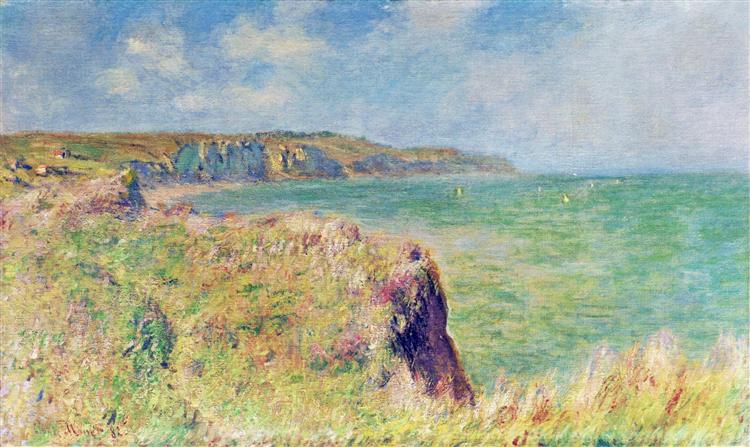Description
Claude Monet's "Edge of the Cliff at Pourville" (1882) is a fascinating example of how the French-British artist managed to capture the essence of light and atmosphere in his painting. Through his distinctive impressionist style, Monet offers a glimpse of a tranquil coastal scene, which is both a celebration of nature and an exploration of the changing light that floods it. Framed by a cliff at the edge of the ocean, the work reflects the painter's intimate relationship with the landscape, accentuating his ability to observe and translate the complexity of the environment into vibrant brushstrokes.
The composition is characterized by a predominance of green and blue tones that evoke the freshness of the sea and the vegetation surrounding the cliff. The gentle curves of the terrain, together with the delimitation of the sky, create a harmonious balance that reflects the dynamism of the landscape. In the upper part of the painting, the sky is bathed in a luminous golden light that mixes with white clouds, creating an ethereal atmosphere. This characteristic reflects Monet's particular technique of working with light and color throughout his work, seeking to capture not only the physical appearance of his surroundings, but also the sensation that they provoke.
Unlike Monet's other works where prominent human figures appear, in "Edge of the Cliff at Pourville" the presences are subtle. In the foreground, a pair of figures can be glimpsed on the cliff, who are almost insignificant against the majestic immensity of the natural landscape. This inclusion, though diminutive, suggests the human's connection to nature, emphasizing their vulnerability in the face of the grandeur of the natural world. The figures are positioned close to the edge, adding an eerie tension to the serenity of the calm sea, echoing the dualities present in life itself.
Monet painted this work during a period when he had moved away from studio painting, choosing instead to work en plein air, that is, directly outdoors. This method, characteristic of the Impressionists, is evident in the spontaneity of his brushstrokes and the fresh, vibrant palette he uses. His style suggests a fleeting moment, capturing light and colour in their purest state, inviting the viewer to stop and contemplate the ephemeral beauty of the landscape.
It is interesting to consider that Monet was in Pourville, one of the many towns on the Normandy coast that impressed him; this particular place would also be a point of reference for other artists of his time. The way Monet reproduces the transition between light and shadow, as well as the depths of the sea, leads us to reflect on his tireless curiosity and passion for the natural environment.
In the context of his career, "Edge of the Cliff at Pourville" is a work that reflects not only his evolution as a master of color and light, but also his devotion to the landscape that surrounded him. This work, like many others in Monet's corpus, speaks of a time and place where art and nature are intertwined, and where each brushstroke is imbued with the emotion and immediacy of the moment. Thus, "Edge of the Cliff at Pourville" stands not only as a graphic representation of a landscape, but as a visceral interpretation of the life that Kozn had begun to define in the Impressionist landscape.
KUADROS ©, a famous painting on your wall.
Hand-made oil painting reproductions, with the quality of professional artists and the distinctive seal of KUADROS ©.
Painting reproduction service with satisfaction guarantee. If you are not completely satisfied with the replica of your painting, we will refund 100% of your money.

